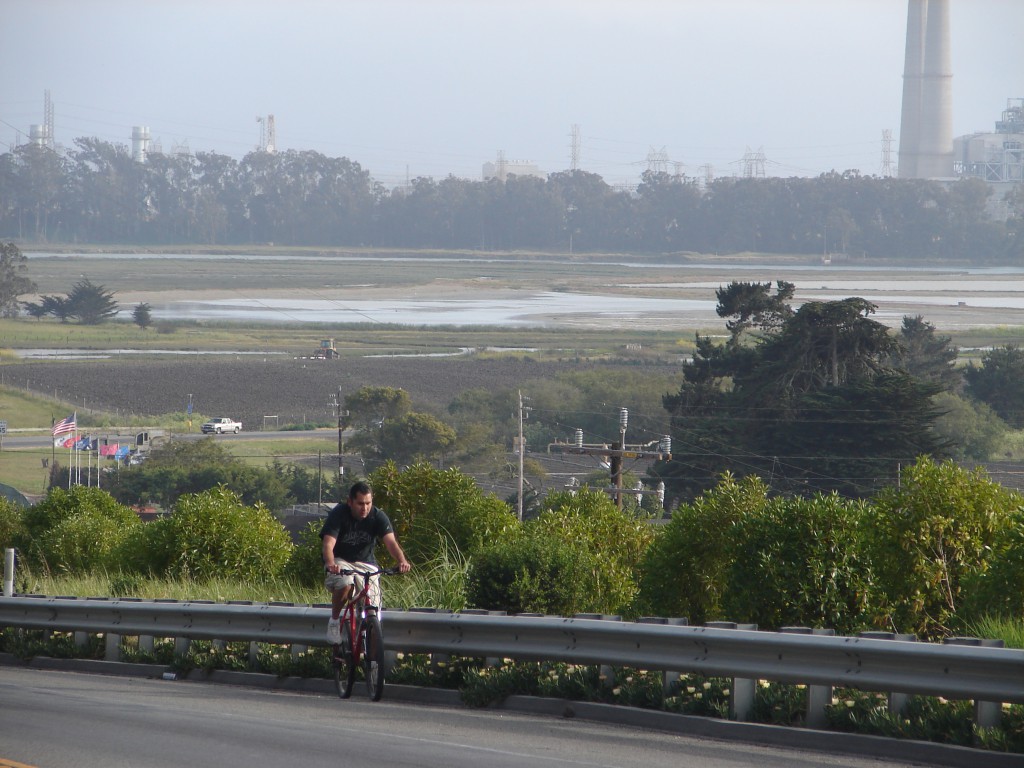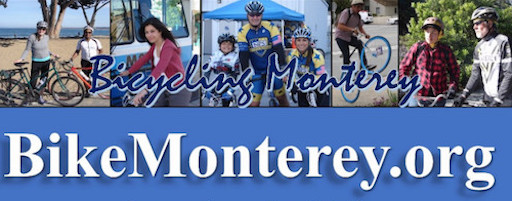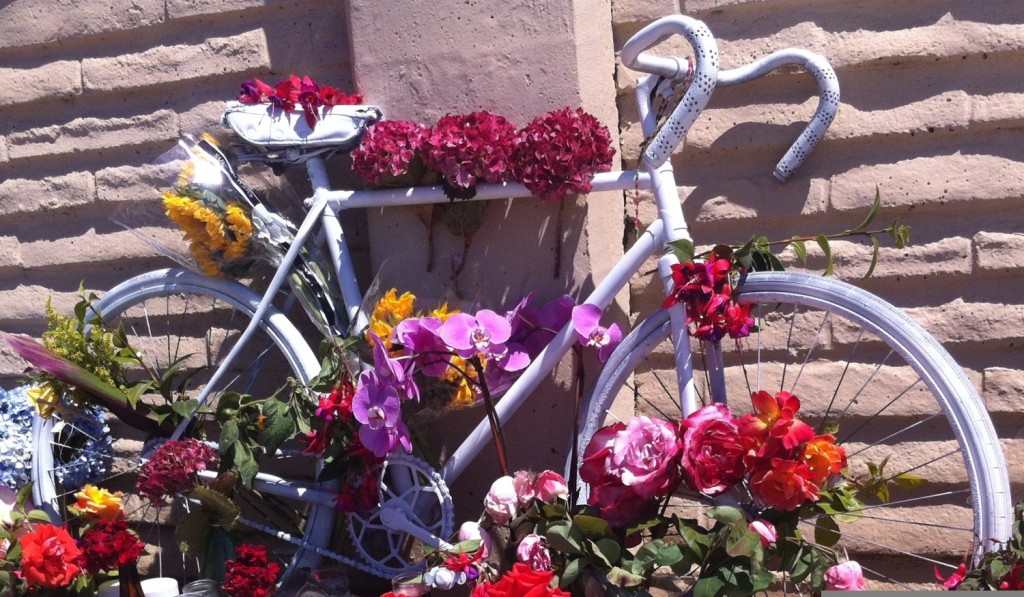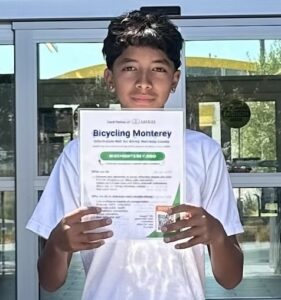Posted by Founder, Bicycling Monterey
Moss Landing, North Monterey County: Infrastructure update
12/11/22 update: “Moss Landing segment of scenic trail on hold ‘indefinitely,’” by Anna Marie Yanny for the Monterey Herald, Dec 11, 2022. https://www.montereyherald.com/2022/12/11/moss-landing-segment-of-scenic-trail-on-hold-indefinitely/
12/1/22 update: https://bikemonterey.org/monterey-bay-sanctuary-scenic-trail-moss-landing-segment.html
10/19/17 update: “Moss Landing bridge, pathway project gets $7.5 million from state, key link in Monterey Bay Sanctuary Scenic Trail,” by Jim Johnson in the 10/19/17 Monterey County Herald.
* * *
This post was previously published 7 May 2016.
The Salinas Californian’s May 5, 2016 “We Could Car Less” column, “Funds sought for north county projects,” mentions Transportation Agency for Monterey County’s “Grant applications for state funds through the Active Transportation Program.” Ms. Eddy reported, “most of the money — $13.8 million — would be used for improvements in north county, specifically Moss Landing and Las Lomas….” She poses the question, “would the improvements make it safer and easier for residents to bicycle to work and school?”
Regarding the proposed pedestrian/bicycle bridge for Highway 1, Moss Landing—one piece of the Monterey Bay Sanctuary Scenic Trail network, which will eventually extend from Lovers Point, Pacific Grove in Monterey County to the San Mateo County line in north Santa Cruz County—it makes sense that Ms. Eddy speculates, “I think tourists would be the main beneficiaries of the Moss Landing bridge.”
Certainly tourists will benefit, including such visitors as Santa Cruz County teens who bike from Santa Cruz to Monterey, and others too. Among Monterey Bay region neighbors who bike Hwy 1, Moss Landing regularly is this Santa Cruz resident, shown on arrival at Monterey’s Custom House Plaza.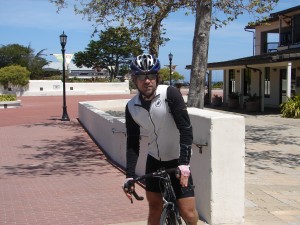 Below is another Santa Cruz County resident who biked Hwy 1, Moss Landing. It was part of his route when biking to the Carmel Bach Festival. He’s pictured after reaching HER Helmet Thursdays spot Parker-Lusseau’s shop in the historic Fremont Adobe on Hartnell Street, Monterey.
Below is another Santa Cruz County resident who biked Hwy 1, Moss Landing. It was part of his route when biking to the Carmel Bach Festival. He’s pictured after reaching HER Helmet Thursdays spot Parker-Lusseau’s shop in the historic Fremont Adobe on Hartnell Street, Monterey.
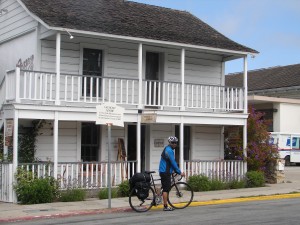 I’ve also met visitors who biked Hwy 1, Moss Landing who’ve come from not just the Monterey Bay region but also from throughout California, the U.S., and other countries. Among visitors pictured on bikemonterey.org who are biking Moss Landing are the German visitors pictured below.
I’ve also met visitors who biked Hwy 1, Moss Landing who’ve come from not just the Monterey Bay region but also from throughout California, the U.S., and other countries. Among visitors pictured on bikemonterey.org who are biking Moss Landing are the German visitors pictured below. 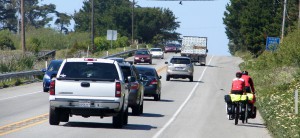 Others include the French visitors below. I first met them in Monterey and provided them with Moss Landing tips to prepare them for the tricky sections of road they’d face.
Others include the French visitors below. I first met them in Monterey and provided them with Moss Landing tips to prepare them for the tricky sections of road they’d face.
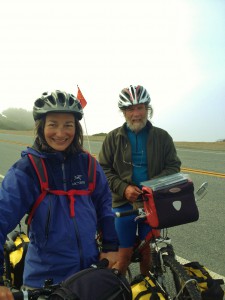
Among the approximately 4.6 million overnight visitors to Monterey County annually, plus millions more day visitors—who benefit the local economy, expand our thinking, and enrich our lives—an increasing number of those visitors like to bike while they’re here.
When one considers the environmental as well as economic benefits, plus reduced traffic congestion, of having more visitors bike, walk, run, or skate along the Monterey Bay Sanctuary Scenic Trail (of which the Hwy 1 Moss Landing bridge is one component), then continuing with projects to complete the trail network’s infrastructure has wider appeal.
However, it’s not just visitors who’ll make use of the improved infrastructure.
Local residents will benefit from
Hwy 1, Moss Landing improvements too!
The large photo at the top of this post, and the photo directly below and another at the end of this post, show just two of the many locals who bike Hwy 1, Moss Landing. The younger of the two, shown below, is a bike-to-work commuter who biked this road regularly, traveling from his home in Watsonville (just over the Monterey County line) to his job at Community Hospital of the Monterey Peninsula.
As my 2011 post about the Monterey Bay Sanctuary Scenic Trail network reminds, biking on the wrong side of the road is illegal and dangerous. But as this photo from that 2011 post shows, when biking uphill, he thought (erroneously) maybe it would be safer to travel, albeit illegally, against traffic–as a pedestrian is legally supposed to do. Makes sense he was struggling to feel safe amidst the typically heavy, highway-speed traffic of this road. (But no, it’s still more dangerous to bike against traffic.)
You can see that this man biking to and from his job in Monterey County is among those who’d benefit from improved infrastructure.
What’s one of the main factors to improve bike/walk safety—and widely accepted as the most important factor? Infrastructure improvements!
Did you know? Many girls, like this teen from Monterey, formerly of Great Britain, love to bike to get where they need to go. But…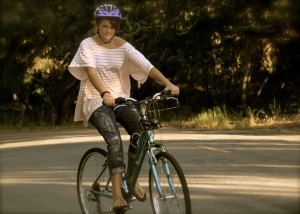
Others, like the girl on the right, from Castroville, are hesitant. Her friend (at left), from Salinas, bikes regularly with her dad. Why doesn’t the Castroville girl bike often too? Sometimes teens express they are worried about bike security, or maybe feeling like a nerd if they wear a helmet as required by CA law. But guess what another very big reason is?
Girls in the film linked below, “Beauty and the Bike,”make clear that one reason why many stop cycling is…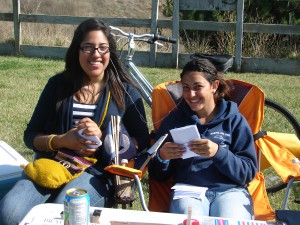
Infrastructure!
If you’re a longtime Bicycling Monterey subscriber you likely have picked up on that reason, maybe even back in 2010 when the film “Beauty and the Bike” was shared, toward the end of the “Bicycle Culture and Youth” post. Yes, infrastructure—roads, bridges, and more—that aren’t conducive to safety can stop many teens, and adults, from biking. Jump to 4:36 in “Beauty and the Bike” and you’ll hear a girl say she felt really safe on the roads where she was visiting, compared to where she was from. She said that on the roads back home, you can “get quite tense and uptight, but here you can just relax.”
And surely unsafe infrastructure is why many parents don’t want their teenagers to bike, or even bike-and-ride. (As for younger kids, it’s generally accepted that kids before approximately age 13 don’t really have the ability to judge vehicle speed and distance that would allow them to bike safely in the street.)
Bicycling Monterey’s section on “Riding Skills, Safety, and California Bike Laws–for Children, Teens, and Adults” starts with…
What makes biking safer?
-
Infrastructure improvements
-
Responsible behavior of people who bike, drive, walk, skate, or otherwise get about
-
Effective laws
-
Law enforcement
-
And simply an increase in the numbers of people who bike makes communities safer for biking too
Step by step, infrastructure improvements are happening.
Knowing that improved bike/walk infrastructure is a critical factor in supporting more teens, and adults, in getting out to enjoy the multiple benefits of healthy, active transportation makes that price tag on a needed bridge look like a smart long-term investment in public health, environment, economy, and more.
“The proposed bicycle/pedestrian bridge in Moss Landing would close a gap in the Monterey Bay Sanctuary Scenic Trail” network, as Ms. Eddy reported. Although the bridge funds are a large expenditure, that work has been identified by transportation planners and engineers as a key component of this important transportation network. Completing the projects in the Monterey Bay Sanctuary Scenic Trail network is a priority for TAMC staff and most others who advocate for improved transportation infrastructure. This North County bridge has long been in the works.
Many people complain about poor bicycle and pedestrian infrastructure but relatively few get involved in improving it, partly because it takes a lot of patient effort. The public is welcome to all meetings of the Transportation Agency of Monterey County’s Bicycle and Pedestrian Facilities Advisory Committee. Check out the list of members and you’ll see there are numerous vacancies. (Read on and you’ll understand why.) Contact TAMC if you’d like to be considered for a vacancy. Ms. Eddy is to be commended for being among those who get involved! She often attends bike-ped meetings, offers input, and reports to the public via her “We Could Car Less” column.
Tip of the helmet also to people who volunteer, alongside employees of various public agencies and other organizations, all serving together on the Transportation Agency of Monterey County’s Bicycle and Pedestrian Facilities Advisory Committee. From the newest committee member, North County’s Supervisorial District 2 representative Jerry Ramos of Castroville, to committee veterans of many years, including North Monterey County High School instructor Dennis L. Johnson of Carmel, the bike-ped committee members contribute by identifying and reporting on needs, following the meeting agendas month after month, and continuing to give input as solutions are developed, reviewed, and approved or rejected.
Some of the committee members have been active bike-ped advocates for many years. This advocacy work requires patiently waiting while the wheels of bureaucracy slowly turn, studies are done, projects are designed and planned, public input is solicited and reviewed, proposals are reviewed and–it’s hoped–approved by TAMC’s board of directors (or it’s back to the drawing board). Of course, securing funding for an approved project is a big task in itself. Finally, construction happens. (And this is just a brief summary of only some of the many steps required between the time that infrastructure needs are first identified and finally met.)
It’s very important to me and numerous other bike/walk advocates that people who bike and walk in North (and South) Monterey County get needed infrastructure improvements. There remains a common misperception that biking and walking is mostly important on the Monterey Peninsula, because of the prominence of its Class I coastal trail. But many of us spend lots of hours over many years advocating for increased recognition of unaddressed needs of people who bike and walk elsewhere in Monterey County. That includes Salinas, our largest city, and it also includes our smaller communities in South County (e.g., Gonzales, Greenfield, King City, San Ardo, and Soledad) and North County (e.g., Castroville, Moss Landing, Pajaro and Prunedale).
If you’re thinking about equity, note the income differences in the chart found in Bicycling Monterey’s Spanish resources compilation. You’ll see, for example, that the North County community of Castroville has far lower household income as compared to peninsula cities such as Carmel.
If you’re wondering why someone would bike all that way to work at CHOMP, maybe it’s because this young man simply likes to bike to work! Or maybe it’s because working in a hospital reminds him of the health benefits of biking. Or maybe he wants to do his part to reduce carbon emissions and other pollution. Or maybe it’s any of 20 reasons why biking is beneficial, including the cost savings of biking–no car payments, insurance, gas purchases, costly maintenance bills, etc.
Whatever the reason that people bike Highway 1 Moss Landing—be they locals or visitors—here’s to TAMC being able to get the vital, most appropriate funding to make this piece of the Monterey Bay Sanctuary Scenic Trail network safer for all.
Scroll below his photo if you found info of value in this post, or would like more North County info.
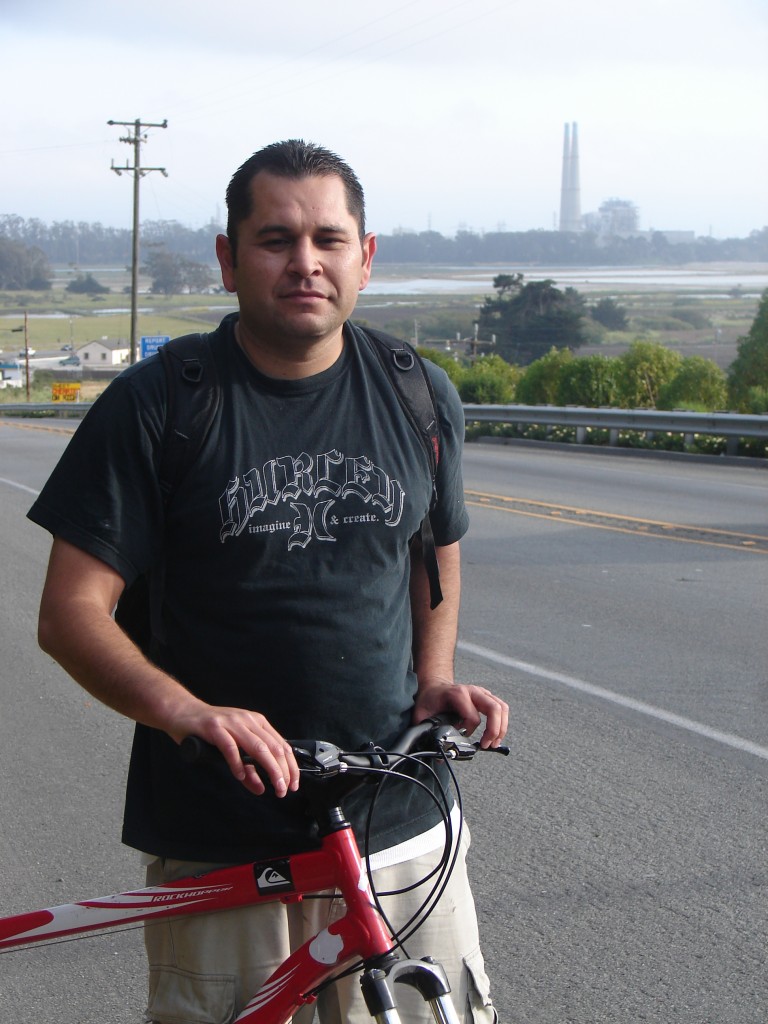 If you find the Bicycling Monterey website or other Bicycling Monterey projects of value,
If you find the Bicycling Monterey website or other Bicycling Monterey projects of value,
click here for payment options and FAQs. Thank you.
Are you in North County? Among a vast amount of info and resources on the Bicycling Monterey website, you may find these of particular interest…
Castroville library’s new bike-related collection! Click here for details.
Bike Castroville tips, including North Monterey County HER Helmet Thursdays spots
Let’s Get Connected: South Santa Cruz/North Monterey Counties
This post was first published 7 May 2016 with some subsequent updates.
This post was published on 20 October 2017. One or more changes last made to this post on 11 December 2022.


